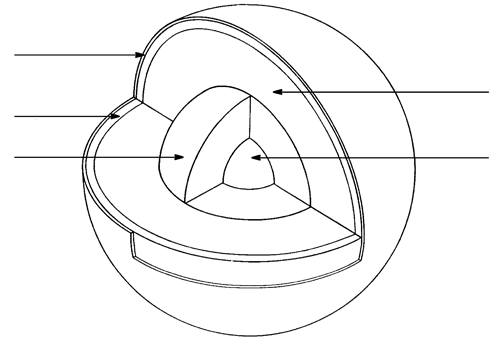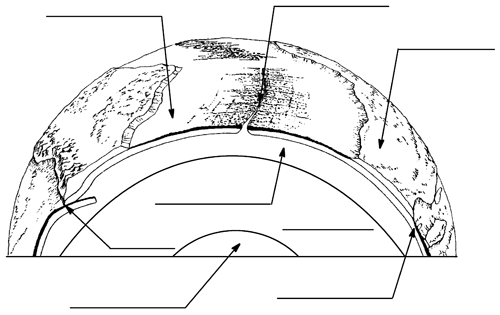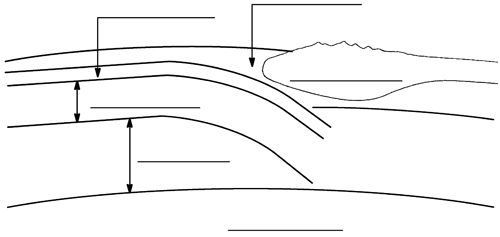Geology 200
Study Guide
Unit 1:
Introduction to Physical Geology
Overview
Unit 1 presents a framework for understanding the processes that form the materials that make up the solid Earth and gives an overview of important geological concepts, many of which will be discussed further in later units.
The first two sections deal with rock formation. Section 1 introduces physical geology and discusses Earth systems. Section 2 examines the structure of the Earth, the processes occurring inside it, and the theory of plate tectonics. Section 3 deals with surficial processes—weathering and erosion—that affect the formation of sedimentary rocks. Finally, Section 4 introduces the idea of geological time. In geological terms, a few million years is a rather short time span. It is important to keep in mind that many of the processes discussed in physical geology here take place over millions, or even hundreds of millions of years.
Objectives
After completing this unit, you should be able to
- name and describe the process by which hot material moves deep in the Earth.
- describe the internal structure of the Earth.
- list the fundamental difference between continents and ocean basins.
- define each of the terms listed below, and explain the differences among them.
- lithosphere
- asthenosphere
- atmosphere
- hydrosphere
- list and describe the three major types of plate boundaries (assisted by labelled diagrams).
- draw and label a diagram to illustrate the processes involved in the Earth’s hydrologic cycle.
- list and describe the three major types of plate boundaries (assisted by labelled diagrams).
- explain the concept of equilibrium as it affects minerals at the Earth’s surface.
- define each of the terms listed below.
- weathering
- erosion
- lithification
- state the estimated dates of the formation of the Earth, the extinction of dinosaurs, and the arrival of human beings.
- explain uniformitarianism.
- list the names of the geological eras and periods in their correct relative time sequence.
Section 1: Introduction to Physical Geology
Geology is the study of the structure of the Earth, how it began, and the processes that have shaped it through time. The role that geology plays in our day-to-day lives is unlimited. The water we drink, the soil in which food grows, construction materials, fossil fuels, and metals used in a broad range of functions are just a few examples that illustrate the central role of geology in our lives. To impress upon you the relevance of this course, we will briefly explore the benefits of studying geology in this section.
The second part of the section introduces the various systems of the Earth that constitute physical geology. In particular, you will learn that physical geology is the branch of Earth science that examines materials that make up the Earth, the processes within the Earth and at its surface, and the forces that drive those processes.
Reading Assignment
Plummer, C. C., Carlson, D. H., & Hammersley, L. Physical Geology (15th ed.).
- “Who Needs Geology?” (pp. 3-8).
- “Earth Systems” (pp. 8-9).
Note: This is a digital textbook (eTextbook). If you haven’t already done so, access or download it now through the link on the course home page.
Study Questions
- Name the four subsystems that constitute the Earth system.
- Which of the four subsystems do we concentrate on most in physical geology?
Section 2: Structure and Processes of the Earth’s Interior and the Theory of Plate Tectonics
As you will learn in this section, the Earth is differentiated into layers. Each layer is composed of material of a characteristic density: heavy material is concentrated towards the centre of the Earth, and lighter material tends to be located near the surface. The Earth’s solid inner core is composed predominantly of iron and nickel; its liquid outer core is also composed of iron and nickel, in molten form. The thick, surrounding mantle is composed of silicate minerals (minerals that contain large amounts of silica) that are rich in iron and magnesium. The crust is composed of rocks exposed at the surface of the Earth. These layers are illustrated in Figure 1.7 of the textbook.
When geologists discuss the dynamic layers of the Earth, they use the terms lithosphere, asthenosphere, hydrosphere, and atmosphere. The lithosphere consists of the crust and the uppermost part of the mantle, both of which behave as if they are rigid. The asthenosphere, a soft, plastic zone in the mantle, underlies the lithosphere. The hydrosphere refers to waters; and the atmosphere refers to the air or layer of mixed gases that forms the outermost layer of the Earth.
Plate tectonics addresses the nature of the lithosphere, which is broken into rigid plates that move (relative to one another) as they slide on the underlying asthenosphere. There are three types of boundaries between plates:
- divergent plate boundaries: where the boundaries of plates are moving apart, hot mantle material rises and forms new plate material. For example, the mid-Atlantic ridge occurs at a divergent plate boundary.
- convergent plate boundaries: where plates are moving together, plates are destroyed in “subduction zones,” as one plate plunges down into the hotter mantle below. A convergent plate margin lies along the volcanic islands of Tonga, the Mariana, and the Aleutians in the eastern Pacific region. Folded mountain ranges, volcanic arcs, and deep-sea trenches are features that form at converging plate margins.
- transform plate boundaries: where plates slide past one another, it creates a fault. The San Andreas Fault in California is an example of a transform boundary.
Reading Assignment
Plummer, C. C., Carlson, D. H., & Hammersley, L. Physical Geology (15th ed.).
- “An Overview of Physical Geology—Important Concepts” (pp. 10-18, up to but excluding “Surficial Processes: The Earth’s External Heat Engine”).
Study Questions
Label the following diagram of the Earth, showing the location of the asthenosphere, the inner core, the outer core, the lithosphere, and the mantle. Identify the material characteristic of each zone as solid and rigid, solid and plastic, or liquid.

Adapted from Hamblin, W. K. (1989). Physical geology: Study guide to accompany the Earth’s dynamic systems (5th ed.) (p. 10). New York: MacMillan.
- The outer layer of the Earth is called the crust. Identify the two types of crust, and discuss the differences between them.
- Define each of the terms listed below.
- lithosphere
- asthenosphere
- atmosphere
- hydrosphere
- Identify and discuss, briefly, the three major types of plate boundaries.
Label the basic elements of the tectonic system shown on the figure below.

Adapted from Hamblin, W. K. (1989). Physical geology: Study guide to accompany the Earth’s dynamic systems (5th ed.) (p. 24). New York: MacMillan.
What kind of plate margin is shown in the following figure? Label the features indicated, and show where you would expect to find volcanoes.

Adapted from Hamblin, W. K. (1989). Physical geology: Study guide to accompany the Earth’s dynamic systems (5th ed.) (p. 9). New York: MacMillan.
- Draw a simple diagram of a mid-oceanic ridge, and label the important features.
Section 3: Processes at the Earth’s Surface
In this section we examine processes that operate on rocks at the Earth’s surface. Essentially, rock is consolidated (solidified) material consisting of grains of one or more minerals. Minerals are crystalline solids with characteristic chemical and physical properties. Both rocks and minerals are inorganic, and both are formed by natural processes. Rocks are classified according to the kinds of processes that formed them; these processes and the rocks that result from them are the subjects of Units 2-5.
The textbook is not clear on the distinction between cementation and lithification. A lithified rock is a rock in which the grains do not separate easily. Cementation, the addition of a binding material between the grains of a rock, is a process by which lithification can take place. Other lithification processes include compaction: a loss of volume under pressure; and recrystallization: the formation of new crystals in a rock, under the influence (usually) of heat and pressure. Weathering may be described as the disintegration and decomposition of material at the Earth’s surface.
Reading Assignment
Plummer, C. C., Carlson, D. H., & Hammersley, L. Physical Geology (15th ed.).
- “Surficial Processes: The Earth’s External Heat Engine” (pp. 18-19).
- “Earth Systems—The Hydrologic Cycle” (pp. 231-232 of Chapter 10).
Study Questions
- Study Figure 10.1 in the textbook. Identify two processes by which water returns to the atmosphere. What are the two mechanisms by which water precipitated on land can return to the sea? Draw and label your own diagram of the hydrologic cycle.
- List three surficial processes by which rock, originally elevated by the Earth’s internal processes, wears down. Can you think of any others?
- Why will a mineral that formed deep below the Earth’s surface tend to break down at the Earth’s surface?
- What is the distinction between weathering and erosion?
- What is the distinction between lithified and cemented?
Section 4: Geologic Time
In this section you will learn that the study of geology requires a switch from the usual human concept of time to a much longer time span. It is important that you become familiar with the geological time scale as presented in Table 1.2 in the textbook. As all geologists use the era and period names to refer to geologic time periods, you will be expected to be familiar with these as you work through this course.
Reading Assignment
Plummer, C. C., Carlson, D. H., & Hammersley, L. Physical Geology (15th ed.).
- “Geologic Time” (pp. 19-22).
- “The Key to the Past” (p. 179-180 of Chapter 8).
Study Questions
| 15. | a. | What is the current estimate of the age of the Earth? |
| b. | According to recent theory, when did the first dinosaur appear, and when did dinosaurs become extinct? | |
| c. | According to recent theory, when did the first humans appear on Earth? | |
| 16. | What percentage of geologic time does the last century account for? | |
| 17. | Explain the principle of uniformitarianism. Use an example. | |
| 18. | List the names of the geological eras and periods in their correct relative time sequence. Make up your own mnemonic scheme to help you remember the sequence of periods in the time scale. | |
Unit 1 Self Test
You have now finished Unit 1. There is no assignment associated with this unit.

 Introduction
Introduction